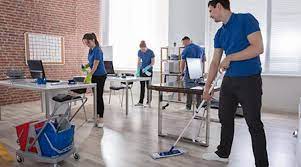When was the last time your office bins were emptied, desks wiped, or carpets deep-cleaned? If you’re not sure, you’re not alone. Many workplaces assume a quick vacuum and the occasional spray of disinfectant is enough to keep things clean. But real office hygiene goes much deeper—and it directly impacts staff health, morale, and even productivity.
In this article, we break down how proper office cleaning works, why it matters more than ever in 2025, and how often you should be reviewing your cleaning schedule.
Why Office Cleaning Should Be a Priority
It’s easy to underestimate the impact of a tidy, hygienic workplace. But offices are high-traffic environments where germs and allergens build up quickly. Door handles, kitchen taps, shared desks and lift buttons—these surfaces are touched hundreds of times a day.
A 2024 study from Safe Work Australia found that improved workplace hygiene led to a 22% reduction in staff sick days over a six-month period. Fewer sick days mean better output and lower disruption—simple changes with big returns.
But it’s not just about illness. A clean, fresh-smelling space makes staff feel valued and more willing to work. It improves first impressions for visitors and contributes to a culture of professionalism.
Common Areas That Demand Attention
Many office managers assume the cleaning team knows what to do. But without a checklist, certain zones are often skipped or done only superficially.
Here’s a breakdown of spaces that need regular attention:
- Workstations – Keyboards, mice and phones can harbour bacteria. Regular sanitising reduces cross-contamination.
- Meeting Rooms – High turnover of users means shared surfaces need wiping down daily.
- Break Rooms & Kitchens – Crumbs, spills, and shared utensils are breeding grounds for germs.
- Bathrooms – Must be cleaned daily with hospital-grade disinfectants, including taps, mirrors, dispensers and floors.
- Reception Areas – Sets the tone for visitors. Clean floors, dust-free surfaces, and streak-free glass are non-negotiable.
- Carpets & Upholstery – Vacuuming is fine for daily upkeep, but steam cleaning should happen at least quarterly.
For a comprehensive guide on scheduling and managing professional cleaning in shared workplaces, check this Safe Work Australia resource.
The Hidden Costs of Skimping on Office Cleaning
There’s a financial trade-off between routine cleaning and reactive maintenance.
Letting hygiene slip may save short-term costs but leads to:
- More staff sick leave
- Increased dust-related issues (allergies, asthma triggers)
- Unpleasant odours
- Faster furniture wear and tear
- Lost business opportunities from a poor visual impression
And then there’s compliance. Australian WHS laws require employers to provide a workplace free from health hazards—including those caused by poor hygiene. Neglecting this can trigger fines or workers’ compensation claims.
If your business hasn’t reviewed its cleaning routine recently, now is the time to audit and revise it with a professional Office Cleaning partner.
Customising Cleaning Based on Office Type
Every office is different. A creative studio with beanbags and open-plan zones has different needs than a high-rise legal firm or co-working space.
Here’s how different office environments might approach cleaning:
- Corporate Offices: Focus on spotless meeting rooms, executive desks, and consistent floor care.
- Shared Workspaces: Frequent disinfecting of hot desks, communal kitchens and collaborative areas.
- Industrial Admin Blocks: Must manage both office grime and tracked-in warehouse dirt.
- Health or Aged Care Offices: Require strict adherence to hygiene protocols, similar to clinical cleaning standards.
Understanding these variations helps guide your Office Cleaning schedule and priorities.
How Often Should an Office Be Professionally Cleaned?
This question comes up often—and the answer depends on your space, foot traffic, and industry. As a general guide:
| Area/Item | Minimum Frequency |
|---|---|
| Bathrooms | Daily |
| Desks & Phones | 2–3 times a week |
| Kitchens | Daily |
| Carpets | Weekly vacuum, quarterly steam clean |
| Windows | Monthly (internal), Quarterly (external) |
| Hard Floors | Weekly mopping, Quarterly polishing |
You might also need deep cleaning every 6–12 months, especially after flu season or before audits.
For help designing a cleaning plan that suits your schedule and compliance needs, consult a specialist in Office Cleaning.
Building a Culture of Clean
Hiring a professional cleaning team is essential, but staff participation helps too.
Encourage small daily actions:
- Wipe your own desk at day’s end
- Empty bins that fill quickly
- Keep shared spaces tidy
- Report hygiene issues early
This shared responsibility reinforces a team culture that values wellbeing.
It also makes it easier for your cleaning contractor to focus on high-level sanitation instead of chasing loose ends.
Final Thoughts
Office cleaning isn’t just a visual upgrade—it’s a business-critical investment in your people and workplace performance. With the right strategy and reliable cleaning routines, you’ll reduce risk, enhance morale and present your company at its best every day.
It starts with a solid plan. Take stock of what needs attention in your space, and don’t wait until dust or odours force your hand. Clean workspaces are productive workspaces—every business deserves that baseline.

